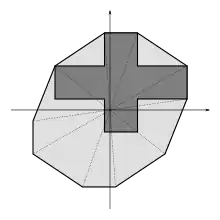Absolutely convex set
In mathematics, a subset C of a real or complex vector space is said to be absolutely convex or disked if it is convex and balanced (some people use the term "circled" instead of "balanced"), in which case it is called a disk. The disked hull or the absolute convex hull of a set is the intersection of all disks containing that set.
Definition

If S is a subset of a real or complex vector space X, then we call S a disk and say that S is disked, absolutely convex, and convex balanced if any of the following equivalent conditions is satisfied:
- S is convex and balanced;
- for any scalars a and b satisfying |a| + |b| ≤ 1, aS + bS ⊆ S;
- for all scalars a, b, and c satisfying |a| + |b| ≤ |c|, aS + bS ⊆ cS;
- for any scalars a1, ..., an satisfying , ;
- for any scalars c, a1, ..., an satisfying , ;
Recall that the smallest convex (resp. balanced) subset of X containing a set is called the convex hull (resp. balanced hull) of that set and is denoted by co(S) (resp. bal(S)).
Similarly, we define the disked hull, the absolute convex hull, or the convex balanced hull of a set S is defined to be the smallest disk (with respect to subset inclusion) containing S.[1] The disked hull of S will be denoted by disk S or cobal S and it is equal to each of the following sets:
- co(bal(S)), which is the convex hull of the balanced hull of S; thus, cobal(S) = co(bal(S));
- Note however that in general, cobal(S) ≠ bal(co(S)), even in finite dimensions,
- the intersection of all disks containing S,
- where the λi are elements of the underlying field.
Sufficient conditions
Properties
- If S is an absorbing disk in a vector space X then there exists an absorbing disk E in X such that E + E ⊆ S.[3]
- The convex balanced hull of S contains both the convex hull of S and the balanced hull of S.
- The absolutely convex hull of a bounded set in a topological vector space is again bounded.
- If D is a bounded disk in a TVS X and if x• = (xi)∞
i=1 is a sequence in D, then the partial sums s• = (sn)∞
i=1 are Cauchy, where for all n, sn := ∑n
i=1 2−i xi.[4]- In particular, if in addition D is a sequentially complete subset of X, then this series s• converges in X to some point of D.
Examples
Although cobal(S) = co(bal(S)), the convex balanced hull of S is not necessarily equal to the balanced hull of the convex hull of S.[1] For an example where cobal(S) ≠ bal(co(S)), let X be the real vector space ℝ2 and let S := {(−1, 1), (1, 1)}. Then bal(co(S)) is a strict subset of cobal(S) that is not even convex. In particular, this example also shows that the balanced hull of a convex set is not necessarily convex. To see this, note that cobal(S) is equal to the closed square in X with vertices (−1, 1), (1, 1), (−1, −1), and (−1, 1) while bal(co(S)) is a closed "hour glass shaped" shaped subset that intersects the x-axis at the origin and is the union of two triangles: one whose vertices are the origin along with S and the other triangle whose vertices are the origin along with −S = {(−1, −1), (1, −1)}.
See also
| The Wikibook Algebra has a page on the topic of: Vector spaces |
References
- Trèves 2006, p. 68.
- Narici & Beckenstein 2011, pp. 67-113.
- Narici & Beckenstein 2011, pp. 149-153.
- Narici & Beckenstein 2011, p. 471.
Bibliography
- Robertson, A.P.; W.J. Robertson (1964). Topological vector spaces. Cambridge Tracts in Mathematics. 53. Cambridge University Press. pp. 4–6.
- Narici, Lawrence; Beckenstein, Edward (2011). Topological Vector Spaces. Pure and applied mathematics (Second ed.). Boca Raton, FL: CRC Press. ISBN 978-1584888666. OCLC 144216834.
- Schaefer, H.H. (1999). Topological vector spaces. Springer-Verlag Press. p. 39.
- Trèves, François (2006) [1967]. Topological Vector Spaces, Distributions and Kernels. Mineola, N.Y.: Dover Publications. ISBN 978-0-486-45352-1. OCLC 853623322.
